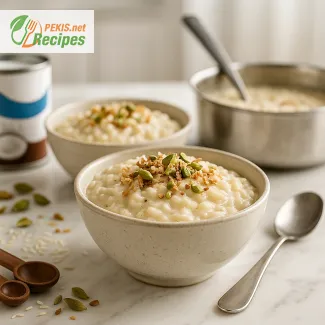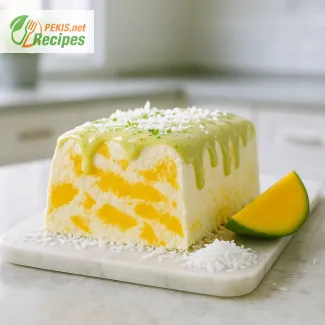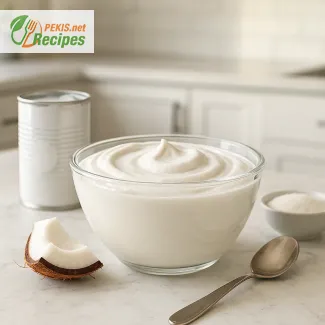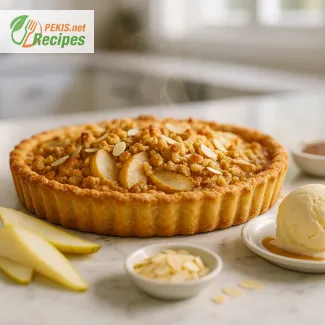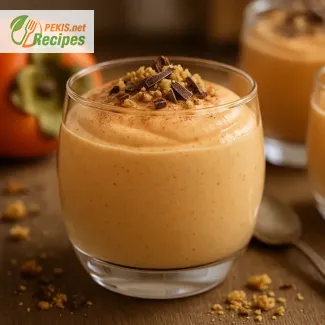
Creamy Vanilla Sauce – A Timeless Touch for Every Dessert
The essence of elegance in classic homemade vanilla sauce
The gentle aroma of fresh vanilla, the smooth texture of warm cream, and the subtle sweetness that enhances every dessert — that’s the magic of creamy homemade vanilla sauce. This silky companion has been a staple in European kitchens for centuries, turning simple sweets into elegant treats. Whether poured over apple strudel, semolina pudding, or a chocolate lava cake, its balance between sweetness and warmth makes it one of the most versatile dessert sauces in the world.
Originating in Central Europe, the traditional Vanillesauce began as a custard-like base enriched with egg yolks, milk, and real vanilla pods. Over time, cooks refined the technique, achieving the perfect blend between thick richness and velvety flow — a sauce that coats the spoon lightly, yet never clings too much. Its roots reach into French pastry traditions, merging with Austrian and German dessert culture, where it became a finishing touch for festive sweets.
The character and texture
A good vanilla sauce isn’t just sweet — it’s balanced. The egg yolks provide smoothness and depth, milk and cream bring richness, while real vanilla adds aromatic complexity that artificial extracts can’t replicate. When warmed gently, the sauce releases a natural fragrance that enhances the flavors of fruit desserts, baked puddings, and pastries. It’s the difference between a simple dessert and a memorable one.
Each spoonful should feel silky, not heavy. Overheating can cause curdling, so patience is key. The process invites calm precision — whisking continuously, feeling the sauce thicken, watching it reach that perfect glossy texture.
Why you’ll love this vanilla sauce
- Versatile pairing: Complements nearly every dessert — from apple strudel to panna cotta.
- Simple ingredients: Uses pantry staples, yet feels luxurious.
- Customizable texture: Easily adjusted from light and pourable to thick and creamy.
- Refined aroma: The natural vanilla notes create a comforting yet elegant finish.
- Traditional roots: Brings a taste of classic European patisserie to your home.
Storage and make-ahead tips
Homemade vanilla sauce can be stored in the refrigerator for up to three days. Keep it in a sealed glass container and reheat gently over low heat while stirring. If it thickens too much after cooling, whisk in a splash of milk to restore the smooth consistency. It can also be served cold — ideal for warm desserts like baked apples or fruit crumbles.
Creative variations
- Caramel vanilla sauce: Add a spoon of caramelized sugar for a deeper amber flavor.
- Citrus twist: Infuse the milk with orange or lemon zest for a refreshing tone.
- Spiced winter version: Add a hint of cardamom, star anise, or nutmeg for cozy seasonal flair.
- Vegan option: Replace dairy with coconut milk and use cornstarch instead of eggs for a plant-based creaminess.
Semantic insight – pairings that highlight vanilla aroma
Vanilla sauce is an emotional link between aroma, comfort, and nostalgia. Its creamy base pairs best with textural contrasts — crispy pastries, baked fruit, or chilled puddings. The combination enhances both flavor and mouthfeel, turning everyday desserts into refined indulgences.
Related recipes to explore
Delight in our other desserts that perfectly match this sauce:
- Classic Apple Strudel with Homemade Vanilla Sauce Recipe
- Chestnut panna cotta with vanilla sauce for autumn days
Both recipes showcase how silky vanilla sauce elevates contrasting desserts — warm, spiced apples or cool, nutty panna cotta. Each variation reflects the same principle: balance, aroma, and texture.
Sensory appeal and cultural legacy
In European culinary heritage, Vanillesauce embodies the essence of home baking and festive hospitality. The soft vanilla fragrance recalls holiday gatherings and cozy family dinners. Its timeless charm lies in versatility — the same sauce graces both rustic and sophisticated desserts. When prepared slowly and served warm, it carries the emotional warmth of tradition with the elegance of fine dining.
Culinary balance and modern relevance
Today’s pastry chefs continue to reinvent this classic by pairing it with lighter desserts and global flavors. Its neutral sweetness and smooth body make it ideal for fusion dishes — from tropical fruit tarts to matcha puddings. Whether you drizzle it or dip into it, vanilla sauce remains a cornerstone of dessert perfection — a silky reminder that simple ingredients, handled with care, create extraordinary results.
- Split the vanilla bean lengthwise and scrape out the seeds. Add both seeds and pod to a saucepan with milk and cream. Warm gently over medium heat until steam forms, but do not boil.
- In a separate bowl, whisk egg yolks, sugar, and cornstarch until the mixture becomes pale and smooth.
- Remove the vanilla pod from the warm milk and slowly pour a little into the egg mixture while whisking constantly to temper it.
- Gradually pour the rest of the hot milk mixture into the bowl, whisking continuously to prevent curdling.
- Return the mixture to the saucepan and cook over low heat, stirring constantly with a spatula, until it thickens enough to coat the back of a spoon (about 82 °C / 180 °F).
- Remove from heat and stir in butter (optional) for a glossy finish and richer texture.
- Strain the sauce through a fine sieve to remove any lumps and achieve a perfectly smooth consistency.
- Serve warm over puddings, fruit desserts, or pastries. Store in the refrigerator for up to three days and reheat gently before serving.
FAQ questionHow do I keep vanilla sauce from curdling?
Curdling happens when egg yolks heat too quickly. To prevent this, always temper the yolks: whisk the yolks with sugar and cornstarch first, then slowly pour in the warm milk-and-cream mixture while whisking constantly. After that, cook the sauce over low heat and keep it moving with a spatula. The ideal thickening point is around 82 °C (180 °F) — above that, the eggs may scramble. If small lumps appear, pass the sauce through a fine sieve while still warm.
FAQ questionCan I make vanilla sauce ahead of time?
Yes. Vanilla sauce keeps well for up to 3 days in the refrigerator in a sealed container. It will thicken slightly as it cools because of the egg yolks and cornstarch. When ready to serve, warm it gently over low heat and whisk in a little milk or cream to restore the original silky texture. Avoid boiling when reheating so the sauce stays smooth and glossy.
FAQ questionWhat’s the difference between vanilla sauce and custard?
They are similar, but vanilla sauce is usually lighter and more pourable. A custard (like crème anglaise) can be thicker and sometimes uses only egg yolks without cornstarch. This vanilla sauce uses milk, cream, egg yolks, sugar, and vanilla for flavor, plus a little cornstarch for stability, so it holds up better when chilled or reheated. It’s designed to be poured over desserts, not cut or scooped.
FAQ questionCan I use vanilla extract instead of a vanilla bean?
Absolutely. A whole vanilla bean gives the deepest aroma and those attractive specks, but 1 tsp vanilla extract added at the end of cooking works very well. Add it off the heat so the flavor doesn’t evaporate. For an even richer profile, you can combine ½ vanilla bean + ½ tsp extract — this keeps the sauce fragrant even after chilling.
FAQ questionHow do I make the sauce thicker or thinner?
For a thicker sauce, increase the cornstarch slightly (to about 15 g / 1½ tbsp) or cook it a bit longer over low heat until it coats the back of a spoon. For a thinner, more pourable sauce, reduce the cornstarch or whisk in extra warm milk after cooking. The texture is very adjustable, so you can tailor it for strudel, bread pudding, pancakes, or chilled desserts.
FAQ questionIs this vanilla sauce gluten-free and how can I adapt it for dairy-free diets?
In its basic form with cornstarch, the sauce is naturally gluten-free. For a dairy-free version, swap milk and cream with oat milk, almond milk, or coconut milk, and replace butter with a plant-based alternative or omit it. Keep the same cooking method — gentle heat, constant whisking — and you’ll still get a smooth, aromatic vanilla sauce suitable for guests with dietary restrictions.
Years of experimenting with European desserts have shown how a well-balanced vanilla sauce can elevate even the simplest sweet into something memorable. The key lies in the smoothness of fresh cream, the warmth of real vanilla, and that patient slow stirring that turns basic ingredients into pure comfort. This recipe reflects a deep appreciation for detail and texture — the kind that makes every spoonful feel luxurious yet familiar.
PEKIS – professional chef and recipe developer with over 25 years of experience in cooking and baking, specializing in European and international cuisine.
A warm drizzle of homemade vanilla sauce has the power to transform even the simplest dessert into a comforting masterpiece. The balance of real vanilla, fresh cream, and slow-cooked eggs creates a silky texture that speaks to the essence of European pastry traditions. Every spoonful reflects patience, care, and the timeless appeal of natural ingredients blended to perfection.
The true charm of this sauce lies in its versatility. Whether it’s poured over a classic apple strudel, a creamy panna cotta, or a rich bread pudding, it enhances both flavor and aroma without overpowering them. Its smooth consistency and delicate sweetness make it an ideal companion for seasonal desserts, warm or cold, year-round.
Beyond its simplicity, this recipe embodies the art of mindful cooking — letting the aroma of vanilla fill the kitchen, watching the sauce slowly thicken, and savoring the result that feels both familiar and indulgent. It’s a reminder that comfort and elegance can coexist in one bowl, created with nothing more than a handful of quality ingredients.
Served warm, it wraps desserts in gentle richness; served cold, it brings a refreshing balance to fruit or pastry. Whichever way it’s enjoyed, this velvety vanilla sauce remains a culinary classic that connects tradition with modern taste — an essential element of every home baker’s repertoire.
Allergens present in the recipe:
- Milk – contains lactose, may cause sensitivity in lactose-intolerant individuals.
- Eggs – common allergen; avoid for those with egg allergies.
- Gluten-free recipe – does not contain gluten.
Ingredient substitution tips:
- Replace milk and cream with almond milk or oat milk for a lactose-free version.
- Substitute egg yolks with cornstarch (additional 5 g / 1 tsp) for a vegan-friendly alternative.
- Use plant-based butter for a dairy-free adaptation.
- Vitamin A (µg): 110 – supports healthy vision and skin.
- Vitamin D (µg): 1.2 – aids calcium absorption and bone health.
- Calcium (mg): 120 – strengthens bones and teeth.
- Iron (mg): 0.4 – contributes to normal oxygen transport in the blood.
- Potassium (mg): 140 – supports normal muscle function.
- Magnesium (mg): 12 – important for metabolism and energy production.
- Vanillin (mg): 8 – natural antioxidant compound from vanilla, supports cellular protection.
- Beta-carotene (mg): 0.2 – minor content from egg yolks, supports immune system function.
- Phenolic compounds (mg): 5 – found in vanilla extract, contribute to anti-inflammatory benefits.
